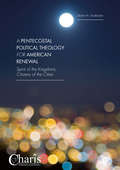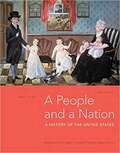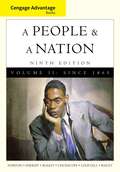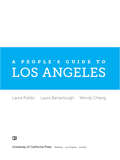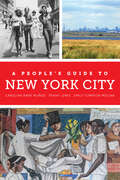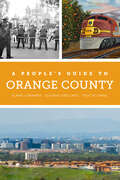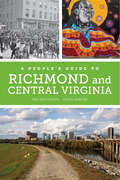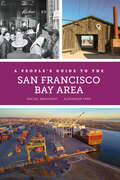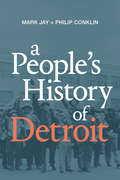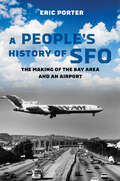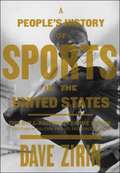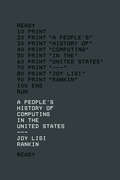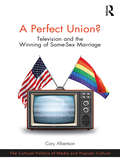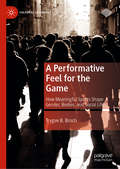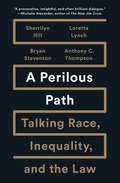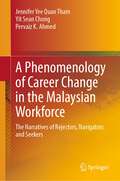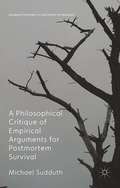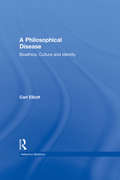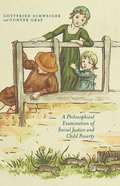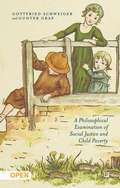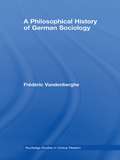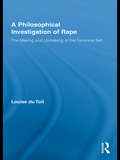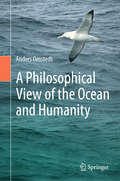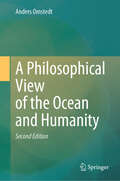- Table View
- List View
A Pentecostal Political Theology for American Renewal: Spirit of the Kingdoms, Citizens of the Cities (Christianity and Renewal - Interdisciplinary Studies)
by Steven M. StudebakerThis book argues that Christians have a stake in the sustainability and success of core cultural values of the West in general and America in particular. Steven M. Studebaker considers Western and American decline from a theological and, specifically, Pentecostal perspective. The volume proposes and develops a Pentecostal political theology that can be used to address and reframe Christian political identity in the United States. Studebaker asserts that American Christians are currently not properly engaged in preventing America’s decline or halting the shifts in its core values. The problem, he suggests, is that American Christianity not only gives little thought to the state of the nation beyond a handful of moral issues like abortion, but its popular political theologies lead Christians to think of themselves more as aliens than as citizens. This book posits that the proposed Pentecostal political theology would help American Christians view themselves as citizens and better recognize their stake in the renewal of their nation. The foundation of this proposed political theology is a pneumatological narrative of renewal—a biblical narrative of the Spirit that begins with creation, proceeds through Incarnation and Pentecost, and culminates in the new creation and everlasting kingdom of God. This narrative provides the foundation for a political theology that speaks to the issues of Christian political identity and encourages Christian political participation.
A People and a Nation, Volume I: To 1877
by David W. Blight Carol Sheriff Jane Kamensky Fredrik Logevall Howard ChudacoffThink history is dull? No way, and you're about to find out for yourself. A PEOPLE AND A NATION offers a lively narrative, telling the stories of the diverse peoples in the United States. The authors bring history to life by encouraging you to imagine what life was really like in the past. Focus questions and key terms (with definitions, of course) help you concentrate on important information and easily review it as you prep for tests. And with MindTap for A People and a Nation, you get convenient digital access to an ebook with note-taking and other time-saving features and apps. You'll also explore the people, events and places in the United States through interactive activities, videos, images and maps. Enjoy your journey.
A People and a Nation: Vol. II, Since 1865 (Ninth Edition)
by Beth Bailey David W. Blight Carol Sheriff David M. Katzman Mary Beth Norton Fredrik Logevall Howard ChudacoffDeveloped to meet the demand for a low-cost, high-quality history book, this economically priced version of A PEOPLE AND A NATION, Ninth Edition, offers readers the complete text while limiting the number of features, photos and maps. All volumes feature a paperback, two-color format that appeals to those seeking a comprehensive, trade-sized history text. A PEOPLE AND A NATION is a best-selling text offering a spirited narrative that tells the stories of all people in the United States. The authors' attention to race and racial identity and their inclusion of everyday people and popular culture brings history to life, engaging readers and encouraging them to imagine what life was really like in the past.
A People's Guide to Los Angeles
by Laura Pulido Laura Barraclough Wendy ChengA People's Guide to Los Angeles offers an assortment of eye-opening alternatives to L.A.'s usual tourist destinations. It documents 115 little-known sites in the City of Angels where struggles related to race, class, gender, and sexuality have occurred. They introduce us to people and events usually ignored by mainstream media and, in the process, create a fresh history of Los Angeles. Roughly dividing the city into six regions--North Los Angeles, the Eastside and San Gabriel Valley, South Los Angeles, Long Beach and the Harbor, the Westside, and the San Fernando Valley--this illuminating guide shows how power operates in the shaping of places, and how it remains embedded in the landscape.
A People's Guide to New York City (A People's Guide Series #5)
by Penny Lewis Emily Tumpson Molina Carolina Bank MuñozThis alternative guidebook for one of the world’s most popular tourist destinations explores all five boroughs to reveal a people’s New York City. The sites and stories of A People’s Guide to New York City shift our perception of what defines New York, placing the passion, determination, defeats, and victories of its people at the core. Delving into the histories of New York's five boroughs, you will encounter enslaved Africans in revolt, women marching for equality, workers on strike, musicians and performers claiming streets for their art, and neighbors organizing against landfills and industrial toxins and in support of affordable housing and public schools. The streetscapes that emerge from these groups' struggles bear the traces, and this book shows you where to look to find them. New York City is a preeminent global city, serving as the headquarters for hundreds of multinational firms and a world-renowned cultural hub for fashion, art, and music. It is among the most multicultural cities in the world and also one of the most segregated cities in the United States. The people that make this global city function—immigrants, people of color, and the working classes—reside largely in the so-called outer boroughs, outside the corporations, neon, and skyscrapers of Manhattan. A People’s Guide to New York City expands the scope and scale of traditional guidebooks, providing an equitable exploration of the diverse communities throughout the city. Through the stories of over 150 sites across the Bronx, Manhattan, Queens, Brooklyn and Staten Island as well as thematic tours and contemporary and archival photographs, a people’s New York emerges, one in which collective struggles for justice and freedom have shaped the very landscape of the city.
A People's Guide to Orange County (A People's Guide Series #4)
by Gustavo Arellano Thuy Vo Dang Elaine LewinnekThe full and fascinating guidebook that Orange County deserves.A People’s Guide to Orange County is an alternative tour guide that documents sites of oppression, resistance, struggle, and transformation in Orange County, California. Orange County is more than the well-known images on orange crate labels, the high-profile amusement parks of Disneyland and Knott’s Berry Farm, or the beaches. It is also a unique site of agricultural and suburban history, political conservatism in a liberal state, and more diversity and discordance than its pop-cultural images show. It is a space of important agricultural labor disputes, segregation and resistance to segregation, privatization and the struggle for public space, politicized religions, Cold War global migrations, vibrant youth cultures, and efforts for environmental justice. Memorably, Ronald Reagan called Orange County the place "where all the good Republicans go to die," but it is also the place where many working-class immigrants have come to live and work in its agricultural, military-industrial, and tourist service economies. Orange County is the fifth-most populous county in America. If it were a city, it would be the nation’s third-largest city; if it were a state, its population would make it larger than twenty-one other states. It attracts 42 million tourists annually. Yet Orange County tends to be a chapter or two squeezed into guidebooks to Los Angeles or Disneyland. Mainstream guidebooks focus on Orange County’s amusement parks and wealthy coastal communities, with side trips to palatial shopping malls. These guides skip over Orange County’s most heterogeneous half—the inland space, where most of its oranges were grown alongside oil derricks that kept the orange groves heated. Existing guidebooks render invisible the diverse people who have labored there. A People’s Guide to Orange County questions who gets to claim Orange County’s image, exposing the extraordinary stories embedded in the ordinary landscape.
A People's Guide to Richmond and Central Virginia (A People's Guide Series #6)
by Melissa Dawn OotenAn expansive guide for resistance and solidarity across this storied region. Richmond and Central Virginia are a historic epicenter of America’s racialized history. This alternative guidebook foregrounds diverse communities in the region who are mobilizing to dismantle oppressive systems and fundamentally transforming the space to live and thrive. Featuring personal reflections from activists, artists, and community leaders, this book eschews colonial monuments and confederate memorials to instead highlight movements, neighborhoods, landmarks, and gathering spaces that shape social justice struggles across the history of this rapidly growing area. The sites, stories, and events featured here reveal how community resistance and resilience remain firmly embedded in the region’s landscape. A People’s Guide to Richmond and Central Virginia counters the narrative that elites make history worth knowing, and sites worth visiting, by demonstrating how ordinary people come together to create more equitable futures.
A People's Guide to the San Francisco Bay Area (A People's Guide Series #3)
by Rachel Brahinsky Alexander TarrAn alternative history and geography of the Bay Area that highlights sites of oppression, resistance, and transformation.A People’s Guide to the San Francisco Bay Area looks beyond the mythologized image of San Francisco to the places where collective struggle has built the region. Countering romanticized commercial narratives about the Bay Area, geographers Rachel Brahinsky and Alexander Tarr highlight the cultural and economic landscape of indigenous resistance to colonial rule, radical interracial and cross-class organizing against housing discrimination and police violence, young people demanding economically and ecologically sustainable futures, and the often-unrecognized labor of farmworkers and everyday people.The book asks who had—and who has—the power to shape the geography of one of the most watched regions in the world. As Silicon Valley's wealth dramatically transforms the look and feel of every corner of the region, like bankers' wealth did in the past, what do we need to remember about the people and places that have made the Bay Area, with its rich political legacies? With over 100 sites that you can visit and learn from, this book demonstrates critical ways of reading the landscape itself for clues to these histories. A useful companion for travelers, educators, or longtime residents, this guide links multicultural streets and lush hills to suburban cul-de-sacs and wetlands, stretching from the North Bay to the South Bay, from the East Bay to San Francisco. Original maps help guide readers, and thematic tours offer starting points for creating your own routes through the region.
A People's History of Detroit
by Mark Jay Philip ConklinRecent bouts of gentrification and investment in Detroit have led some to call it the greatest turnaround story in American history. Meanwhile, activists point to the city's cuts to public services, water shutoffs, mass foreclosures, and violent police raids. In A People's History of Detroit, Mark Jay and Philip Conklin use a class framework to tell a sweeping story of Detroit from 1913 to the present, embedding Motown's history in a global economic context. Attending to the struggle between corporate elites and radical working-class organizations, Jay and Conklin outline the complex sociopolitical dynamics underlying major events in Detroit's past, from the rise of Fordism and the formation of labor unions, to deindustrialization and the city's recent bankruptcy. They demonstrate that Detroit's history is not a tale of two cities—one of wealth and development and another racked by poverty and racial violence; rather it is the story of a single Detroit that operates according to capitalism's mandates.
A People's History of SFO: The Making of the Bay Area and an Airport
by Eric PorterAn illuminating profile of the San Francisco Bay Area, and its regional and global influence, as seen from the focal point of San Francisco International Airport (SFO).A People's History of SFO uses the history of San Francisco International Airport (SFO) to tell a multifaceted story of development, encounter, and power in the surrounding region from the eighteenth century to the present. In lively, engaging stories, Eric Porter reveals SFO's unique role in the San Francisco Bay Area's growth as a globally connected hub of commerce, technology innovation, and political, economic, and social influence. Starting with the very land SFO was built on, A People's History of SFO sees the airport as a microcosm of the forces at work in the Bay Area—from its colonial history and early role in trade, mining, and agriculture to the economic growth, social sanctuary, and environmental transformations of the twentieth century. In ways both material and symbolic, small human acts have overlapped with evolving systems of power to create this bustling metropolis. A People's History of SFO ends by addressing the climate crisis, as sea levels rise and threaten SFO itself on the edge of San Francisco Bay.
A People's History of Sports in the United States: 250 Years of Politics, Protest, People, and Play
by David ZirinTo those who scoff at the idea that sports counts in the real world, casually bring up Jackie Robinson, Babe Didrikson Zaharias and Kenichi Zenimura, whose dedication to baseball created major-league-level play in internment camps during World War II. Journalist Zirin gives due credit to the unsung, pointing out the very close relationship between the idols and lesser idols of sports and the city functionaries, mayors, governors, legislators and presidents who courted them. The endorsement of a sports hero was magic, of course, and the support of the politicos created venues, stadiums and parks, but as Zirin points out, how sport has been played in America and by whom (and watched by whom) are not-so-subtle inside looks into the heart of America. Readers can opt for just enjoying the sports stories; more likely, they will see how sport raised us up and let us down as a people. Annotation ©2008 Book News, Inc., Portland, OR (booknews.com) A People's History of Sports in the United States is replete with surprises for seasoned sports fans, while anyone interested in history will be amazed by the connections Zirin draws between politics and pop flies. As Jeff Chang, author of Can't Stop Won't Stop, puts it, "After you read him, you'll never see sports the same way again." Dave Zirin is the author of three books, including What's My Name, Fool? and Welcome to the Terrordome. He writes the popular weekly online sports column The Edge of Sports and is a regular contributor to The Nation, SLAM, and the Los Angeles Times. He lives in Takoma Park, Maryland.
A People's History of the Farmers' Movement, 2020–2021
by Sabah Siddiqui Shamsher SinghIn the annals of India’s history, a monumental uprising unfolded in 2020, echoing the resilience and coming together of large sections of its agrarian base. Instigated by the contentious farm laws of 2020, the Farmers’ Movement burgeoned into a year-long saga of protest and perseverance, ending only in December 2021 after the passing of the Farm Laws Repeal Bill, 2021 by the Indian Parliament. From the initial demand for law repeal to the multifaceted growth of the movement, the book traces the journey of the Farmers’ Movement, as each essay dissects the socio-political dynamics, cultural nuances, and mass solidarity that underpinned the protests, including focused analyses from Delhi, Punjab, Haryana, Uttar Pradesh, Rajasthan, Maharashtra, and the Sikh diaspora in the United Kingdom. This anthology chronicles the ebb and flow of a nation’s spirit, encapsulating the symbiotic relationship between theory and praxis, between change and continuity. It serves as a testament to the power of collective resistance and a roadmap for future struggles, ensuring that the legacy of the Farmers’ Movement endures beyond the pages of history.This volume is an interdisciplinary project and will be of interest to scholars from diverse fields such as economics, sociology, public policy, political science, history, political geography, gender studies, cultural studies, international studies, architecture, media studies, psychology, and ethnomusicology.
A People’s History of Computing in the United States
by Joy Lisi RankinDoes Silicon Valley deserve all the credit for digital creativity and social media? Joy Rankin questions this triumphalism by revisiting a pre-PC time when schools were not the last stop for mature consumer technologies but flourishing sites of innovative collaboration—when users taught computers and visionaries dreamed of networked access for all.
A Perfect Union?: Television and the Winning of Same-Sex Marriage (The Cultural Politics of Media and Popular Culture)
by Cory AlbertsonOn June 26, 2015, Supreme Court Justice Anthony Kennedy declared same-sex marriage "is so ordered" across the United States. The day will no doubt be remembered as a landmark shift in how U.S. society views and validates marriage and romantic relationships. But the shift would not have happened without an arguably more important, but already forgotten, shift four years earlier that saw unprecedented movement in public attitudes alongside record amounts of television representation of LGBQ relationships. Situated at this intersection of legislative, attitudinal and representational change, A Perfect Union? presents analyses of popular programmes such as Modern Family, Grey’s Anatomy, The Good Wife, Glee, Desperate Housewives and House in order to tackle crucial ethical questions regarding the impact of heterosexual knowledges on the rendering of same-sex relationships as relatable and "respectable" – portraits of heteronormativity that reproduce the masculine/feminine binary, monogamous coupledom and the raising of children. Focusing on the connection between heteronormativity and government legitimacy, Cory Albertson deftly examines television’s privileging of certain forms of relationships over others, shedding light on the reproduction of everyday power relations within LGBQ relationships that hinge on issues of race, sexuality, class and gender. An engaging study of media constructions of same-sex relationships and the shaping of public expectations and attitudes, A Perfect Union? is a must-read for scholars of sociology, media and cultural studies and popular culture with interests in gender, sexuality and the family.
A Performative Feel for the Game: How Meaningful Sports Shape Gender, Bodies, and Social Life (Cultural Sociology)
by Trygve B. BrochApplying a cultural sociology of performance, this book interrogates how the meaning of sport intersects with gender. Trygve B. Broch points out uncertainties in the causal arguments made by key figures in the cultural studies tradition, instead advancing a meaning-centered study of sports as involving both a social and an athletic performance. Sports not only reflect or reverse social realities, but capture and keep our attention when we use and experience them as a means to reflect on social life, injustice, and hierarchy. More specifically, blending approaches from media studies with ethnography, Broch explores the women-dominated sport of handball in Norway, a country that considers gender equality a basis of democracy. As such, the analyses here show how broadly available meanings about sameness and equality are mediated and experienced through a performative feel for the game.
A Perilous Path: Talking Race, Inequality, and the Law
by Sherrilyn Ifill Bryan Stevenson Anthony C. Thompson Loretta LynchThis blisteringly candid discussion of the American dilemma in the age of Trump brings together the head of the NAACP Legal Defense Fund, the former attorney general of the United States, a bestselling author and death penalty lawyer, and a star professor for an honest conversation the country desperately needs to hear. Drawing on their collective decades of work on civil rights issues as well as personal histories of rising from poverty and oppression, these leading lights of the legal profession and the fight for racial justice talk about the importance of reclaiming the racial narrative and keeping our eyes on the horizon as we work for justice in an unjust time.
A Phenomenology of Career Change in the Malaysian Workforce: The Narratives of Rejectors, Navigators and Seekers
by Pervaiz K. Ahmed Jennifer Yee Tham Yit Sean ChongEvolution in economy, technology and social institutions over time have given rise to boundaryless and Protean careers that promote mobility and self-direction in managing one’s career. This has led to the phenomenon of career change whereby individuals undertake a shift from one field of work to a completely different field of work. In career change research, career changers have been studied as a collective, singular group undergoing a similar change experience, which neglects individual differences that may contrast the experience of change from one changer to another. Furthermore, the emotional experience that accompanies a career change has been examined with a primary focus on the role of positive emotions, which overlooks the role of negative emotions in career change. Thus, this book sheds light on three key narratives of career change; Rejectors, Navigators and Seekers, that were identified in a phenomenological study of career change amongst Malaysian working adults. Semi-structured interviews were conducted with 30 career changers across age, gender and ethnicity with a focus on how they made sense and meaning of their lived experience of career change within their environment and context. Each career change narrative was found to have different characteristics, motivations and behaviors respectively, which shaped their unique career change process. Negative emotions were also revealed as key drivers of the career change process, although each narrative expressed different types of negative emotions.Finally, the book also introduces an adaptive perspective to career development by way of the Adaptive Career Construal Model (ACCM) which was proposed based on the continuous bi-directional relationship between career decisions and career outcomes.
A Philosophical Critique of Empirical Arguments for Postmortem Survival (Palgrave Frontiers in Philosophy of Religion)
by Michael SudduthSudduth provides a critical exploration of classical empirical arguments for survival arguments that purport to show that data collected from ostensibly paranormal phenomena constitute good evidence for the survival of the self after death. Utilizing the conceptual tools of formal epistemology, he argues that classical arguments are unsuccessful.
A Philosophical Disease: Bioethics, Culture, and Identity (Reflective Bioethics)
by Carl ElliottFirst published in 1999. Routledge is an imprint of Taylor & Francis, an informa company.
A Philosophical Examination of Social Justice and Child Poverty
by G. Schweiger G. GrafThis book is open access under a CCBY license. This book investigates child poverty from a philosophical perspective. It identifies the injustices of child poverty, relates them to the well-being of children, and discusses who has a moral responsibility to secure social justice for children.
A Philosophical Examination of Social Justice and Child Poverty
by Gunter Graf Gottfried SchweigerThis book is open access under a CCBY license.  Child poverty is one of the biggest challenges of today, harming millions of children. In this book, it is investigated from a philosophical social justice perspective, primarily in the context of modern welfare states. Based on both normative theory (particularly the capability approach) and empirical evidence, the authors identify the injustices of child poverty, showing how it negatively affects the well-being of children as well as their whole life course. But child poverty is not 'givenby nature'. It is avoidable and there is certainly the moral duty to alleviate it. Therefore, Graf and Schweiger develop a normative theory of responsibilities, which clarifies the moral role of different agents in the poor child's environment: the family, the state and many others, that have so far been neglected in philosophical theories. They conclude their book by sketching how their theory can be extended to global child poverty and what it means to show equal respect and concern for everychild  - no matter where and in which context they were born.
A Philosophical History of German Sociology (Routledge Studies in Critical Realism)
by Frédéric VandenbergheA Philosophical History of German Sociology presents a systematic reconstruction of critical theory, from the founding fathers of sociology (Marx, Simmel, Weber) via Lukács to the Frankfurt School (Horkheimer, Adorno, Habermas). Through an in depth analysis of the theories of alienation, rationalisation and reification, it investigates the metatheoretical presuppositions of a critical theory of the present that not only highlights the reality of domination, but is also able to highlight the possibilities of emancipation. Although not written as a textbook, its clear and cogent introduction to some of the main theories of sociology make this book a valuable resource for undergraduates and postgraduates alike. The following in-depth investigation of theories of alienation and reification offer essential material for any critique of the dehumanizing tendencies of today’s global world. Recently translated into English from the original French for the first time, this text showcases Vandenberghe's mastery of the German, French and English schools of sociology study. The result is an important and challenging text that is essential reading for sociology students of all levels. Frédéric Vandenberghe is a Sociology professor and researcher at Iuperj (Instituto Universitário de Pesquisas do Rio de Janeiro), Rio de Janeiro, Brazil. His writings on a broad range of sociological topics have been published as books and articles around the world.
A Philosophical Investigation of Rape: The Making and Unmaking of the Feminine Self (Routledge Research in Gender and Society)
by Louise du ToitThis book offers a critical feminist perspective on the widely debated topic of transitional justice and forgiveness. Louise Du Toit examines the phenomenon of rape with a feminist philosophical discourse concerning women’s or ‘feminine’ subjectivity and selfhood. She demonstrates how the hierarchical dichotomy of male active versus female passive sexuality – which obscures the true nature of rape – is embedded in the dominant western symbolic frame. Through a Hegelian and phenomenological reading of first-person accounts by rape victims, she excavates an understanding of rape that also starts to open up a way out of the denial and destruction of female sexual subjectivity.
A Philosophical View of the Ocean and Humanity (Springerbriefs In Environmental Science Ser.)
by Anders OmstedtThis book is about the ocean and about the future. It is written in two modes, a concerned analytical scientific mode and an intuitive artistic mode in which the ocean is given a voice. The disconnect in the relationship between human dependency on and feelings about the ocean is examined in a dialogue between these two modes. The book illustrates how science and the arts can be connected to increase our awareness of the state of the ocean and support behavioural change. This book is intended for everyone who would like to contribute to the sustainable use of the ocean. Includes forewords by Alice Newton, University of Algarve, Portugal and Martin Visbeck, GEOMAR, Helmholtz Centre for Ocean Research, Kiel, Germany.
A Philosophical View of the Ocean and Humanity: Second Edition
by Anders OmstedtThis book provides an overview of major threats to our blue planet. But also tools for connecting facts and values to change our often destructive behavior towards nature. The solutions to achieving an ocean in harmony with man are within us, where compassion, curiosity, empathy, courage, and creativity are needed for sustainable change. Therefore, with this book, I want to arouse your curiosity and give the reader, the courage to face the future better by introducing tools for deep diving into our outer and inner world with many hidden resources. The book brings the reader into humans' challenges with the ocean and its future. It addresses some of the main questions in the United Nations Ocean Decade initiative that aims to change how humans deal with the ocean. This unique book will stimulate a broad way of thinking by connecting analytical science thinking and intuition. In the book's first part, art and dreams are used to connect science and art. This knowledge is then applied in part II of the book, written in two modes: a concerned science mode and an intuitive, artistic mode in which the ocean is given a voice. Part III illustrates how science and art can be connected to increase our awareness of the state of the ocean and support behavioral change.
